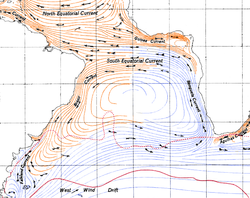

(warm in red, cold in blue)
The South Atlantic Gyre is the subtropical gyre in the south Atlantic Ocean. In the southern portion of the gyre, northwesterly (or southeastward-flowing) winds drive eastward-flowing currents that are difficult to distinguish from the northern boundary of the Antarctic Circumpolar Current. [1] Like other oceanic gyres, it collects vast amounts of floating debris as a garbage patch. [2]
